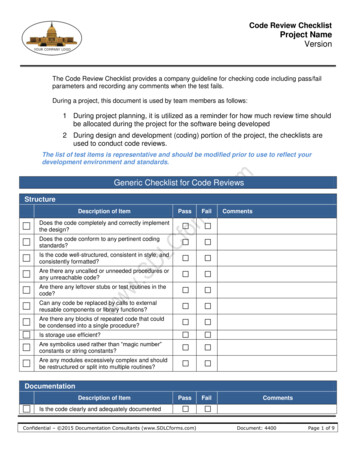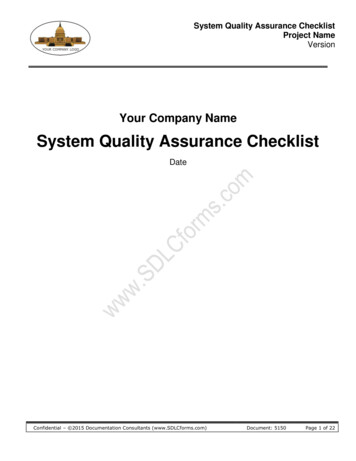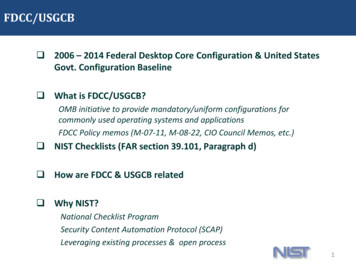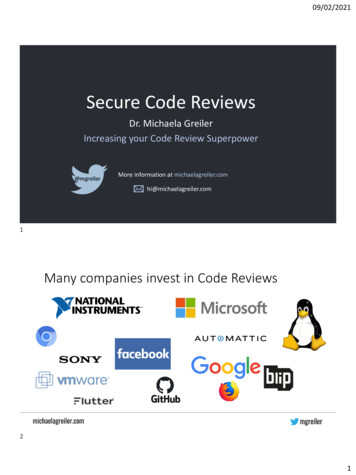
Transcription
Code Review ChecklistProject NameVersionThe Code Review Checklist provides a company guideline for checking code including pass/failparameters and recording any comments when the test fails.During a project, this document is used by team members as follows:1 During project planning, it is utilized as a reminder for how much review time shouldbe allocated during the project for the software being developed2 During design and development (coding) portion of the project, the checklists areused to conduct code reviews.The list of test items is representative and should be modified prior to use to reflect yourdevelopment environment and standards.Generic Checklist for Code ReviewsStructureDescription of ItemPassFailPassFailCommentsDoes the code completely and correctly implementthe design?Does the code conform to any pertinent codingstandards?Is the code well-structured, consistent in style, andconsistently formatted?Are there any uncalled or unneeded procedures orany unreachable code?Are there any leftover stubs or test routines in thecode?Can any code be replaced by calls to externalreusable components or library functions?Are there any blocks of repeated code that couldbe condensed into a single procedure?Is storage use efficient?Are symbolics used rather than “magic number”constants or string constants?Are any modules excessively complex and shouldbe restructured or split into multiple routines?DocumentationDescription of ItemCommentsIs the code clearly and adequately documentedConfidential – 2015 Documentation Consultants (www.SDLCforms.com)Document: 4400Page 1 of 9
Code Review ChecklistProject NameVersionwith an easy-to-maintain commenting style?Are all comments consistent with the code?VariablesDescription of tsAre all variables properly defined with meaningful,consistent, and clear names?Do all assigned variables have proper typeconsistency or casting?Are there any redundant or unused variables?StyleDescription of ItemDoes the code follow the style guide for thisproject?Is the header information for each file and eachfunction descriptive enough?Is there an appropriate amount of comments?(frequency, location, and level of detail)Is the code well structured? (typographically andfunctionally)Are the variable and function names descriptiveand consistent in style?Are "magic numbers" avoided? (use namedconstants rather than numbers)Is there any “dead code” (commented out code orunreachable code) that should be removed?Is it possible to remove any of the assemblylanguage code, if present?Is the code too tricky? (Did you have to think hardto understand what it does?)Did you have to ask the author what the codedoes? (code should be self-explanatory)ArchitectureDescription of ItemIs the function too long? (e.g., longer than fits onone printed page)Can this code be reused? Should it be reusingsomething else?Confidential – 2015 Documentation Consultants (www.SDLCforms.com)Document: 4400Page 2 of 9
Code Review ChecklistProject NameVersionIs there minimal use of global variables? Do allvariables have minimum scope?Are classes and functions that are doing relatedthings grouped appropriately? (cohesion)Is the code portable? (especially variable sizes,e.g., “int32” instead of “long”)Are specific types used when possible? (e.g.,“unsigned” and typedef, not just "int")Are there any if/else structures nested more thantwo deep? (consecutive “else if” is OK)Are there nested switch or case statements? (theyshould never be nested)Arithmetic OperationsDescription of ItemPassFailCommentsPassFailCommentsDoes the code avoid comparing floating-pointnumbers for equality?Does the code systematically prevent roundingerrors?Does the code avoid additions and subtractions onnumbers with greatly different magnitudes?Are divisors tested for zero or noise?Loops and BranchesDescription of ItemAre all loops, branches, and logic constructscomplete, correct, and properly nested?Are the most common cases tested first in IF- ELSEIF chains?Are all cases covered in an IF- -ELSEIF or CASEblock, including ELSE or DEFAULT clauses?Does every case statement have a default?Are loop termination conditions obvious andinvariably achievable?Are indexes or subscripts properly initialized, justprior to the loop?Can any statements that are enclosed within loopsbe placed outside the loops?Does the code in the loop avoid manipulating theindex variable or using it upon exit from the loop?Confidential – 2015 Documentation Consultants (www.SDLCforms.com)Document: 4400Page 3 of 9
Code Review ChecklistProject NameVersionDefensive ProgrammingDescription of ItemPassFailCommentsPassFailCommentsAre indexes, pointers, and subscripts testedagainst array, record, or file bounds?Are imported data and input arguments tested forvalidity and completeness?Are all output variables assigned?Are the correct data operated on in eachstatement?Is every memory allocation deallocated?Are timeouts or error traps used for externaldevice accesses?Are files checked for existence before attemptingto access them?Are all files and devices left in the correct stateupon program termination?MaintainabilityDescription of ItemDoes the code make sense?Does the code comply with the accepted CodingConventions?Does the code comply with the accepted BestPractices?Does the code comply with the accepted CommentConventions?Is the commenting clear and adequate? (As aguide, each file will have a comment at the start,explaining what the code does, possibly acomment at the start of each function, andcomments as needed to explain complex orobfuscated code.)Are ideas presented clearly in the code?Is encapsulation done properly?Is the code not too complex?Are there no unnecessary global variables?Is the reading order in source code from top tobottom?Are there unused variables or functions?Confidential – 2015 Documentation Consultants (www.SDLCforms.com)Document: 4400Page 4 of 9
Code Review ChecklistProject NameVersionRequirements and FunctionalityDescription of tsPassFailCommentsDoes the code match the requirements,specifications and standards?Is the logic proper? Does the code function asneeded?System and Library CallsDescription of ItemDo all system calls have their return statuschecked?Are all possible errors from system or library callshandled?Are signals caught and handled?Is mutex() used on multithreaded code on globalvariables?ReusabilityDescription of ItemAre all available libraries being used effectively?Are available openmrs util methods known andused?Is the code as generalized/abstracted as it couldbe?Is the code a candidate for reusability?RobustnessDescription of ItemAre all parameters checked?Are error conditions caught?Is there a default case in all switch statements?Is there non-reentrant code in dangerous places?Is the usage of macros proper? (Readability,complexity, portability )Is there unnecessary optimization that may hindermaintainability?Confidential – 2015 Documentation Consultants (www.SDLCforms.com)Document: 4400Page 5 of 9
Code Review ChecklistProject NameVersionSecurityDescription of ItemPassFailCommentsPassFailCommentsDoes the code appear to pose a security concern?Do Service methods have an @Authorizeannotation on themDoes the application use an inclusion list (known,valid, and safe input) rather than an inclusion list(rejecting known malicious or dangerous input)Is all user input encoding set by the server?Is all character encoding set by the server?If cookies contain sensitive data, are they markedsecure?Do input surfaces in Web parts and othercustomizations include boundary checks, inputdata integrity checks, and appropriate exceptionhandling to protect from cross-site scripting andSQL injection.Does the design address potentialcanonicalization issues?Control StructuresDescription of ItemDoes the application log sensitive data in cleartext.Sensitive data is not stored in cookies.Sensitive data is not stored in unencrypted, hiddenform fields or query strings. It is maintained byusing server-side state management.SSL, IPSEC with encryption, or application layerencryption prior to transmittal is sued to protectsensitive data during transmission.Sensitive data is not cached. Output caching is offby default.Sensitive data that is transferred via email usesS/MIME encryption or Information RightsManagement (IRM), depending upon the intendedrecipient.Does the code make use of infinite loops?Does the loop iterate the correct number of times?Confidential – 2015 Documentation Consultants (www.SDLCforms.com)Document: 4400Page 6 of 9
Code Review ChecklistProject NameVersionResource LeaksDescription of ItemPassFailCommentsPassFailCommentsDoes the code release resources?Does the code release resources more than once?Does the code use the most efficient class whendealing with certain resources?Error HandlingDescription of ItemDoes the code comply with the accepted ExceptionHandling Conventions?Does the code make use of exception handling?Does the code simply catch exceptions and logthem?Does the code catch general exception(java.lang.Exception)?Does the code correctly impose conditions for"expected" values?Are input parameters checked for proper values(sanity checking)?Are error return codes/exception generated andpassed back to the calling function?Are error return codes/exceptions handled by thecalling function?Are null pointers and negative numbers handledproperly?Do switch statements have a default clause usedfor error detection?Are arrays checked for out of range indexing? Arepointers similarly checked?Is garbage collection being done properly,especially for errors/exceptions?Is there a chance of mathematicaloverflow/underflow?Are error conditions checked and logged? Are theerror messages/codes meaningful?Would an error handling structure such astry/catch be useful? (depends upon language)Confidential – 2015 Documentation Consultants (www.SDLCforms.com)Document: 4400Page 7 of 9
Code Review ChecklistProject NameVersionTimingDescription of ItemPassFailCommentsPassFailCommentsIs the worst case timing bounded? (no unboundedloops, no recursion)Are there any race conditions? (especially multibyte variables modified by an interrupt)Is appropriate code thread safe and reentrant?Are there any long-running ISRs? Are interruptsmasked for more than a few clocks?Is priority inversion avoided or handled by theRTOS?Is the watchdog timer turned on? Is the watchdogkicked only if every task is executing?Has code readability been sacrificed forunnecessary optimization?Validation & TestDescription of ItemIs the code easy to test? (How many paths arethere through the code?)Do unit tests have 100% branch coverage? (codeshould be written to make this easy)Are the compilation and/or lint checks 100%warning-free? (Are warnings enabled?)Is special attention given to corner cases,boundaries, and negative test cases?Does the code provide convenient ways to injectfaulty conditions for testing?Are all interfaces tested, including all exceptions?Has the worst case resource use been validated?(stack space, memory allocation)Are run-time assertions being used? Are assertionviolations logged?Is there commented out code (for testing) thatshould be removed?Confidential – 2015 Documentation Consultants (www.SDLCforms.com)Document: 4400Page 8 of 9
Code Review ChecklistProject NameVersionHardwareDescription of ItemPassFailCommentsDo I/O operations put the hardware in a correctstate?Are min/max timing requirements met for thehardware interface?Is it ensured that multi-byte hardware registerscan’t change during read/write?Does the software ensure that the system resetsto a well defined hardware system state?Have brownout and power loss been handled?Is the system correctly configured forentering/leaving sleep mode (e.g. timers)?Have unused interrupt vectors been directed to anerror handler?Has care been taken to avoid EEPROMcorruption? (e.g., power loss during write)Confidential – 2015 Documentation Consultants (www.SDLCforms.com)Document: 4400Page 9 of 9
The Code Review Checklist provides a company guideline for checking code including pass/fail parameters and recording any comments when the test fails. During a project, this document is used by team members as follows: 1 During project planning, it is utilized as a reminder for how much review time should










